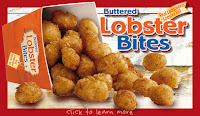 When I saw Long John Silver's ads for Langostino lobster on television, I had a flash of recognition. Because they showed a picture of the Langostino lobster tail, and I thought, "Those are squat lobsters."
When I saw Long John Silver's ads for Langostino lobster on television, I had a flash of recognition. Because they showed a picture of the Langostino lobster tail, and I thought, "Those are squat lobsters."I recognized them because I published a paper on squat lobster motor neurons (Faulkes & Paul, 1997. A map of the distal leg motor neurons in the thoracic ganglia of four decapod crustacean species. Brain, Behavior and Evolution 49(3): 162-178).
I was surprised, because squat lobsters get their name from the fact that their tails are small, and they sit with them normally tucked underneath the rest of their body. They are crunchy little animals with a small tail, slender (though often long) claws -- and there's just not much meat on them. When I was working with them, we would sometimes go out trawling for animals and we'd throw some prawns on the boil for lunch, but nobody ever considered throwing a squat lobster into the pot.
Yet there they were, being advertised and sold on the mass market.
I was reminded of a study of seafood menus that showed how clawed lobster used to be considered trash food rather than a delicacy. Lobster meat moved up in prestige as the preferred fish stocks were depleted.
Now, lobster is too expensive for mass consumption, so squat lobsters are being fished and sold. I don't like the trend. We're just going down and down the food chain as one fishery is depleted after another. What's next? Krill?
"Eat like a whale at Long John Silver's! If krill can feed the largest animals on earth, it can feed you!"

No comments:
Post a Comment
Comments are moderated. Real names and pseudonyms are welcome. Anonymous comments are not and will be removed.